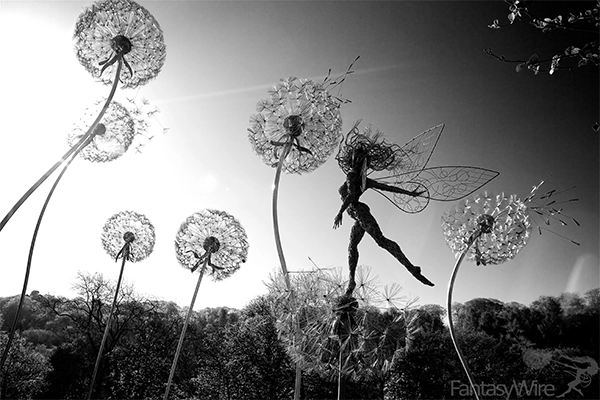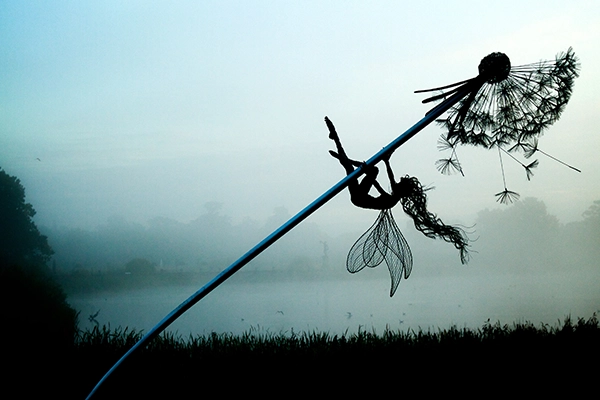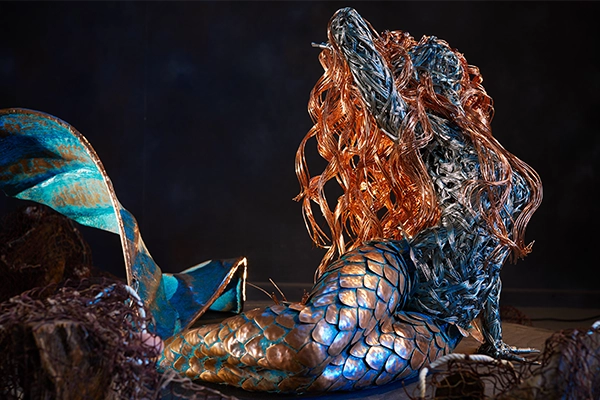27 September 2024
A hilltop for my £10 million fairy
6 minutes
Just as Antony Gormley’s Angel of the North dominates the Tyne skyline, wire sculptor Robin Wight has his sights on creating a giant fairy sculpture that can also be seen for miles
Robin Wight is one of my favourite sculptors and his wire fairies sprinkle magic along Trentham Gardens’ Fairy Trail in Stoke-on-Trent – but he now has much bigger ideas for his work.
Robin’s next goal is to ‘build a world tourist attraction’ by finding a site for one of his giant fairy sculptures on a British hillside.
|
|
From his home in a woodland setting, within a nature reserve in the Staffordshire Moorlands, Robin can see a hill about five miles away and says: “I want to put a fairy on the top of a hill so it that can spin round in the wind and become something that people will be able to recognise from miles away. “It may not be that hill but it has got to be a British hilltop, perhaps near a motorway, so I'm waiting for the planets to align.” Robin started making wire fairies and created his company FantasyWire after a career in computer software design. A couple of company buy-outs put him in a position to concentrate on his ‘hobby’. Robin said: “I had always been arty, and used to win prizes at school, but I never thought about art as a career. My father was an engineer and I went straight into being an apprentice mechanic. “My line of work developed into computers – and that meant quite a lot of travel. The companies tended to be US-based and while I enjoyed visiting Miami and other places I never wanted to live overseas. “By the time I was in my 50s I was free to live and work from family home without any money worries. In fact, that’s where the fairies came in. The woodland is just the sort of place where you can imagine fairies hiding or playing in the trees. |
“It all started when I was putting up a fence and twisting some wire, and I had a thought I could probably sculpt with wire. My first attempt was a crude-shaped fairy. Once I cracked it, I wanted to make fairies to the highest quality.
“Now people to say ‘Wow, how did you do that?’ and I'm constantly trying to think ‘how can I improve on that?’.”
Robin found that the psychology in software design – to understand the customer, solve their problem and create something far better – is much the same as his approach to sculpture.
|
|
He said: “I want to make my sculptures as beautiful as possible, refining them all the time and doing the occasional commission. I only do commissions on my terms, because almost all requests are for the fairy which is the company logo, the fairy that's hanging onto a dandelion that spins around. I nailed the design with that one but I don't want to waste it by diluting it and making multiple copies. “Sometimes with a commission I'll engrave a special message requested by the client and I get a lot of pleasure out of doing that because it's very personal. “I never want there to be more than single figures of each fairy and there’s already six of the ‘logo fairy’ with a dandelion.” Robin is now looking for more exposure to the art world. He said: “It seems that in order to get the art world to listen, you have to be commanding almost £100,000 before they recognise you're on the planet! “I'm what they call an outsider artist because I didn't go to art college or a recognised institution. I haven't shown at the Tate but I've become commercially successful even though the art world doesn't know I exist! |
“The most expensive fairy I sold was about £50,000. I thought I was pricing myself out but the buyer just said he’d take it.
“I don't have any trouble selling my fairies because people aren't buying my work as an investment, they buy because they love them and they are genuinely moved by what I've created.
“However, I'd like to think that the prices will go up and I will get well known so my fairies would be an investment longer term. I've just found a bit of a niche where I genuinely like sharing something nice with the world.
|
|
|
|
|
“I'm still trying to push what I can do with wire and I'm always looking at new ideas. At the moment I'm making a four-foot moon that's covered in copper with a fairy sitting in the crescent of the moon but, really, it’s a giant fairy on a hilltop that’s on my mind.
“I can get involved with the physics and how it could be constructed so I'm just waiting for the pieces to fall in place and working on a business model where I can get people to invest in what I expect to be a £10 million project. The spinning fairy would dominate the skyline and all I want is for people to know the sculpture was created by The Fairyman, Robin Wight. That should get the art world to sit up!”
Visit fantasywire.co.uk
Trentham Gardens trail
In 2012, Robin created a fairy trail at Trentham Gardens. The fairies were made out of fence wire and he says it ‘worked well as it got children to walk around the garden, like a treasure hunt’.
Since then, Robin and the Trentham team have revitalised the fairy trail to make it an exhibition of his work, starting with the early fairies through to the development of sophisticated fairies he creates today. It runs through the heart of the gardens and alongside the mile-long, Capability Brown-designed Trentham Lake with views of the River Trent, ancient wildflower meadows, woodlands, a weir and nature trails. Naturalistic planting is by Nigel Dunnett, who designed the London Olympic Park planting scheme.
Robin worked out where to place each fairy so when visitors are taking pictures, and sharing them on social media, they're showing off Trentham Gardens’ iconic views.
Robin said: “Trentham Estate is in a beautiful setting and the trail is unique because my other sculptures that are on public display are single pieces such as Pensthorpe Nature Park, in Norfolk, where they've got a fairy and some dandelions.”
About Trentham Estate
The 725-acre estate comprises gardens, ancient woodland and a lake as well as an outdoor shopping village but 25 years ago the estate was in rack and ruin. The Dukes of Sutherland had long departed, their vast wealth gone to the wind.
Trentham Hall was demolished a century ago and the land went through various guises; a coal mine, a stage of the RAC Lombard Rally, a caravan park, a fairground and a dance hall which once hosted the Beatles.
It was little more than a dumping ground until it was regenerated in 2000. RHS Gold medal designers Tom Stuart-Smith and Piet Oudolf were signed up and one of the country’s finest head gardeners, Michael Walker, arrived from Waddesdon Manor, in Buckinghamshire, to oversee the transformation.
They were just the latest in a who’s who of garden experts to make their mark on the gardens which were laid out in the 16th century by Lancelot ‘Capability’ Brown and later, Sir Charles Barry’s 19th century Italianate gardens were added.
Sir Charles, it seems, influenced by a grand tour of Europe, helped to spend the Sutherlands’ cash and his extravagance ran into creating the imposing, and now restored, stone balustrade next to the lake.
The revival of the Italian Gardens was led by Tom Stuart-Smith and to the east of the Italian gardens, the Rivers of Grass and Floral Labyrinth were designed by Dutch plantsman Piet Oudolf.
Trentham Estate, Stoke-on-Trent, Staffordshire ST4 8JG is open every day except December 25. Visit trentham.co.uk
Protecting your sculpture – Insurance need to know
If you’ve had a sculpture in your garden for decades, have recently acquired or are considering acquiring a new piece, it’s important to look after it and insure it correctly.
- Above all, from the outset, ensure your sculpture is professionally installed and securely fixed. Depending on value, some insurers may require additional security.
- Some policies may exclude outdoor sculptures or limit the amount payable in the event of a claim – so before you invest in a sculpture, check your policy wording or speak to your broker.
- Specialist items such as statues, sculptures and other garden items, particularly if they are of high value, should be treated as fine art and not simply included under the general contents figure.
- Your insurer may cover your sculptures on an agreed value basis. In any case, you should make sure that you have an up-to-date valuation.
- In the winter, it is well worth protecting old stone with a cover. If you notice any small damage or hairline cracks, get them repaired so moisture cannot get in during freezing temperatures.
If you feel your garden may not be adequately covered under your household insurance policy, call 020 8256 4901 or email privateclients@howdeninsurance.co.uk
If you’re thinking of adding a new piece of sculpture for your garden or looking for inspiration to enhance a particular space, there are a number of spectacular sculpture gardens and exhibitions to visit across the UK: Inspiration to put garden sculpture in the spotlight.





